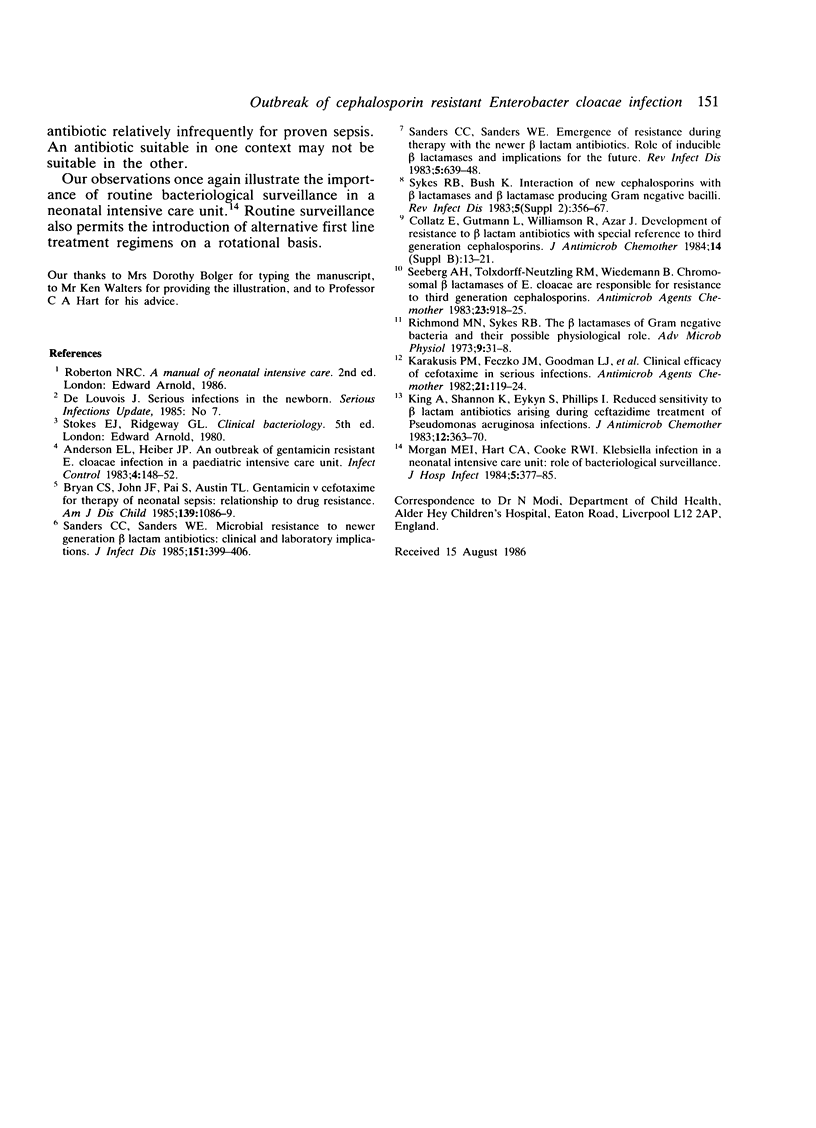Abstract
Enterobacter cloacae resistant to third generation cephalosporins emerged rapidly during an outbreak of serious infections due to this organism in a neonatal intensive care unit where ampicillin and gentamicin were used as first line antibiotic treatment. Organisms resistant to cephalosporins were isolated from 12 infants, six of whom developed systemic infection. Two infants died. Isolates of E. cloacae from four of five infants treated with cefotaxime showed a loss of sensitivity to this antibiotic during treatment, but in the three infants who survived sensitive organisms were again isolated after treatment had stopped. Stopping treatment with the cephalosporins, closure of the unit to new admissions, and strict cohorting of colonised infants resulted in a prompt end to the outbreak. This outbreak suggests that the routine use of third generation cephalosporins for suspected sepsis may be inappropriate in the presence of a large reservoir of organisms with the potential for rapidly developing resistance. Routine bacteriological surveillance, however, might permit their use on a rotational basis.
Full text
PDF



Selected References
These references are in PubMed. This may not be the complete list of references from this article.
- Anderson E. L., Hieber J. P. An outbreak of gentamicin-resistant Enterobacter cloacae infections in a pediatric intensive care unit. Infect Control. 1983 May-Jun;4(3):148–152. doi: 10.1017/s0195941700058069. [DOI] [PubMed] [Google Scholar]
- Bryan C. S., John J. F., Jr, Pai M. S., Austin T. L. Gentamicin vs cefotaxime for therapy of neonatal sepsis. Relationship to drug resistance. Am J Dis Child. 1985 Nov;139(11):1086–1089. doi: 10.1001/archpedi.1985.02140130024022. [DOI] [PubMed] [Google Scholar]
- Collatz E., Gutmann L., Williamson R., Acar J. F. Development of resistance to beta-lactam antibiotics with special reference to third-generation cephalosporins. J Antimicrob Chemother. 1984 Sep;14 (Suppl B):13–21. doi: 10.1093/jac/14.suppl_b.13. [DOI] [PubMed] [Google Scholar]
- Karakusis P. H., Feczko J. M., Goodman L. J., Hanlon D. M., Harris A. A., Levin S., Trenholme G. M. Clinical efficacy of cefotaxime in serious infections. Antimicrob Agents Chemother. 1982 Jan;21(1):119–124. doi: 10.1128/aac.21.1.119. [DOI] [PMC free article] [PubMed] [Google Scholar]
- King A., Shannon K., Eykyn S., Phillips I. Reduced sensitivity to beta-lactam antibiotics arising during ceftazidime treatment of Pseudomonas aeruginosa infections. J Antimicrob Chemother. 1983 Oct;12(4):363–370. doi: 10.1093/jac/12.4.363. [DOI] [PubMed] [Google Scholar]
- Morgan M. E., Hart C. A., Cooke R. W. Klebsiella infection in a neonatal intensive care unit: role of bacteriological surveillance. J Hosp Infect. 1984 Dec;5(4):377–385. doi: 10.1016/0195-6701(84)90005-7. [DOI] [PubMed] [Google Scholar]
- Richmond M. H., Sykes R. B. The beta-lactamases of gram-negative bacteria and their possible physiological role. Adv Microb Physiol. 1973;9:31–88. doi: 10.1016/s0065-2911(08)60376-8. [DOI] [PubMed] [Google Scholar]
- Sanders C. C., Sanders W. E., Jr Emergence of resistance during therapy with the newer beta-lactam antibiotics: role of inducible beta-lactamases and implications for the future. Rev Infect Dis. 1983 Jul-Aug;5(4):639–648. doi: 10.1093/clinids/5.4.639. [DOI] [PubMed] [Google Scholar]
- Sanders C. C., Sanders W. E., Jr Microbial resistance to newer generation beta-lactam antibiotics: clinical and laboratory implications. J Infect Dis. 1985 Mar;151(3):399–406. doi: 10.1093/infdis/151.3.399. [DOI] [PubMed] [Google Scholar]
- Seeberg A. H., Tolxdorff-Neutzling R. M., Wiedemann B. Chromosomal beta-lactamases of Enterobacter cloacae are responsible for resistance to third-generation cephalosporins. Antimicrob Agents Chemother. 1983 Jun;23(6):918–925. doi: 10.1128/aac.23.6.918. [DOI] [PMC free article] [PubMed] [Google Scholar]


